Varicocele Treatment in Chunni-ganj, Kanpur
The enlargement of the veins in the scrotum, a part of the male reproductive system, is referred to as Varicocele. This is quite similar to getting the varicose veins in your leg. Although a benign condition, it can cause discomfort and pain, and may also affect the functionality of your testicles. Varicocele is commonly seen affecting men at young ages, especially boys during their puberty.
What happens when you develop varicocele?
The scrotum is a loose bag of skin that contains the testicles as well as the arteries and veins that deliver blood to the reproductive glands in a male. A varicocele is the result of those veins in the scrotum enlarging or swelling which develop over time. A varicocele can be usually seen on the left side of the scrotum and you can usually see it when you stand up, but not when you lie down. It can exist on both sides although this happens very rarely.

Symptoms of developing a varicocele
Varicocele often exhibits no symptoms, hence you may not notice it until you or your doctor sees it, or you experience the following associated signs:
- A lump in one of the testicles
- Dull and recurring pain in your scrotum
- Swelling in the scrotum
Pain that occurs due to varicocele is observed in rare cases, however, if you do experience pain, it may:
- Get worse when you stand or exert yourself, especially during long periods
- Get more intense over the course of the day
- End when you lie on your back
What causes varicocele?
The exact causes that could lead to the development of a varicocele are still unclear. However, doctors believe that one probable cause that could lead to widening of the veins in the scrotum can be backing up of the blood. A spermatic cord holds up each testicle and also contains the veins, arteries, and nerves that support these glands by carrying blood to and from your testicles. Backing up of blood occurs when the one-way valves inside the veins in the cord prevent your blood from flowing properly. This might cause damage to the testicle and lead to infertility.
Another probable cause is the changes that occur due to puberty. Often because of the quick growth during puberty, the blood requirement of the testicles increases. Any type of problem in the veins can keep the blood from getting where it needs to go, leading to the development of a varicocele.
When to see a doctor?
Since a varicocele usually causes no symptoms, it might be discovered during a fertility evaluation or a routine physical exam. However, if you experience any of the associated symptoms for a prolonged period, or you're having problems with fertility, contact your doctor immediately.
Request an appointment at Apollo Spectra Hospitals, Kanpur
Call1860-500-2244 to book an appointment
Risk Factors and Complications
While there are no certain factors that can increase the risk of developing a varicocele, there are complications that may occur. These include:
- Infertility: Sperm formation, movement, and functions can be affected due to a high temperature that occurs in and around the testicle because of the varicocele.
- Atrophy: This refers to shrinkage and softening of the testicle affected by a varicocele.
How is varicocele treated at Apollo Spectra, Kanpur?
A varicocele treatment might not always be necessary. However, if you experience any persistent symptoms, you might want to undergo surgery for reparation. The goal of these surgeries is to clamp or tie off the abnormal veins that are causing problems in the flow of blood. Post-surgery, the blood will then be able to flow around the abnormal veins to the normal ones.
Different methods for achieving this goal include:
Varicocelectomy: Under local or general anaesthesia, the doctor will make a 1-inch incision into your scrotum. A magnifying glass or microscope to see small veins and repair them better shall be used.
Laparoscopic surgery: This surgery is performed under general anaesthesia. Instead of the scrotum, a small incision is made in your abdomen and to pass a tiny instrument through the incision and be able to see and repair the varicocele.
Percutaneous embolization: This procedure is performed under general anaesthesia but is not as widely used as other surgical methods. It involves passing a tube into a vein in your groin or neck through which instruments can be passed. They’ll use an X-ray monitor to guide them to the varicocele and insert a coil into it through the tube, which interrupts the blood flow and repairs the varicocele.
Your doctor might be able to diagnose the development of a varicocele through a physical exam or a scrotal ultrasound.
The doctor may ask you to perform no exercise for at least 2 weeks post-surgery.
There are certain post-surgery risks like coming back of the varicocele, hydrocele, or injury of the testicular artery. However, these occur very rarely.
Symptoms
Our Doctors
DR. ACHINTYA SHARMA
MBBS, MS,MCh...
| Experience | : | 7 Yeras Experience |
|---|---|---|
| Speciality | : | Vascular Surgery... | Location | : | Chunni Ganj |
| Timings | : | Available by prior a... |
Our Top Specialities
NOTICE BOARD
CONTACT US
CONTACT US
 Book Appointment
Book Appointment



.svg)
.svg)
.svg)
.svg)








